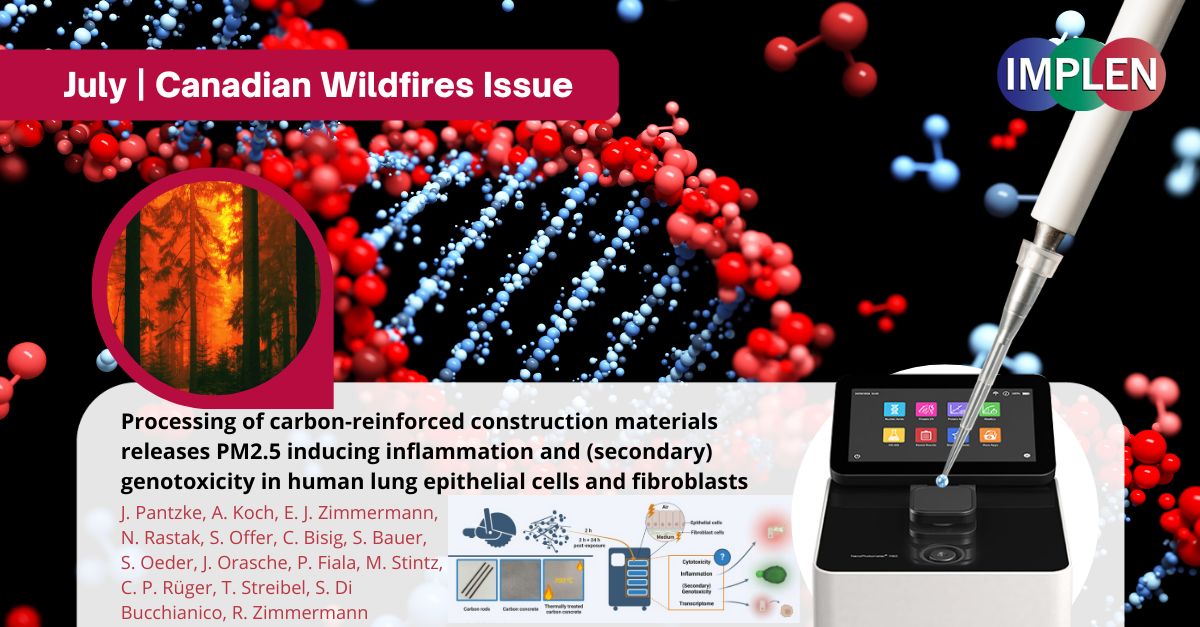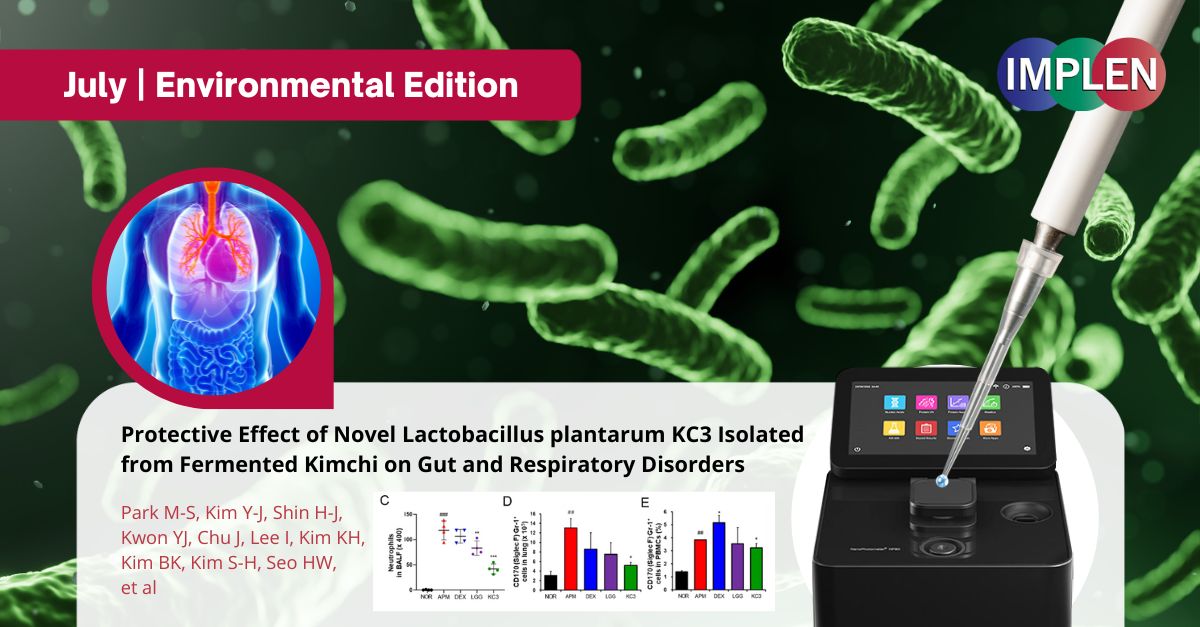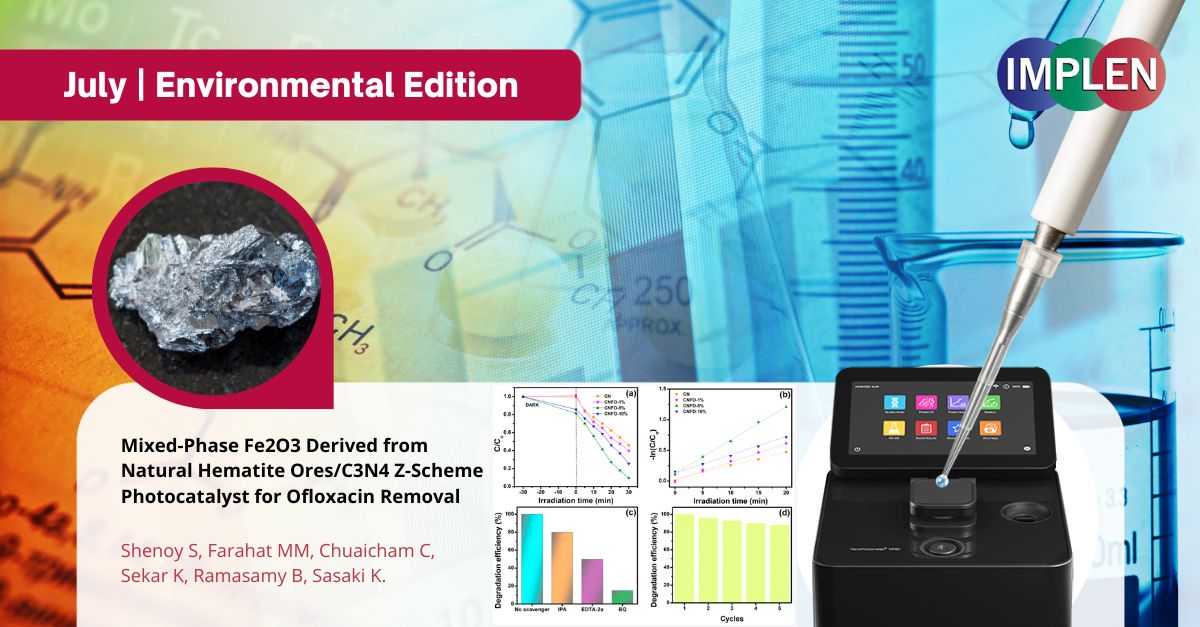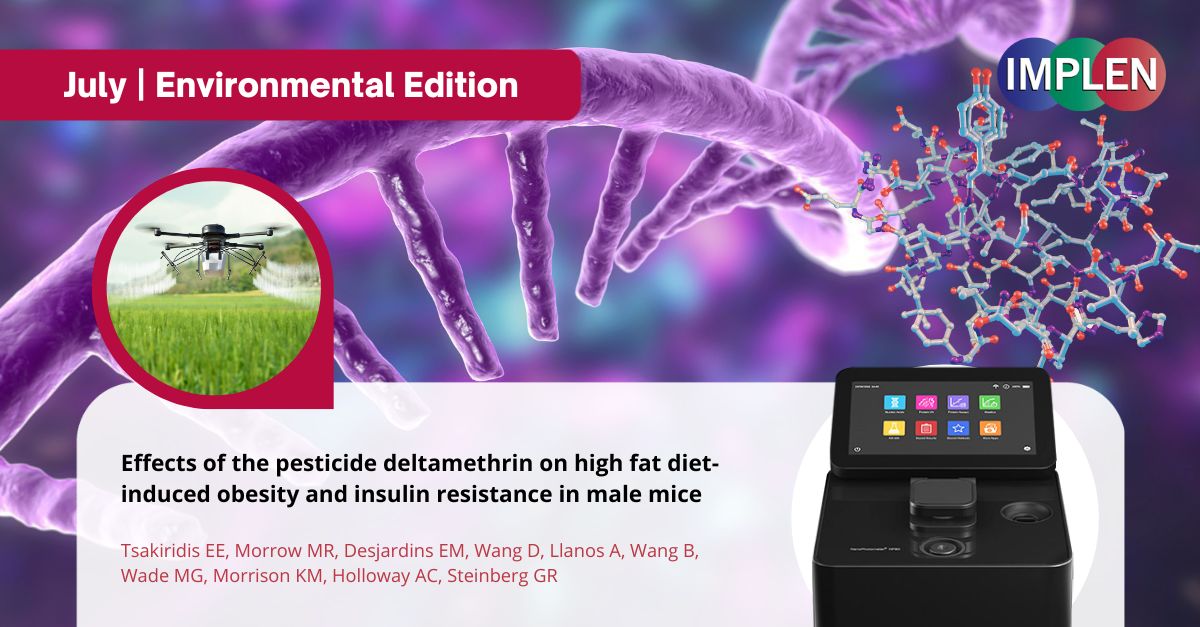Implen Journal Club | July Issue Environmental Edition |
|
The first issue of the Implen NanoPhotometer® Journal Club is delving into the topic of the Canadian wildfires of 2023, which are significantly impacting air quality across North America and Europe. Smoke and pollutants, including PM2.5, are being carried by prevailing winds, causing deteriorating air quality in the United States and reaching European countries. The long-range transport of smoke poses health risks, particularly for vulnerable populations. A recent study published by Pantzke et. al. highlights the use of safe materials, particularly in wooded areas that are susceptible to forest fires. The study demonstrates that the processing of carbon-reinforced construction materials, commonly used in various industries, releases fine particulate matter (PM2.5). These particles, when inhaled, can cause inflammation and secondary genotoxicity in human lung epithelial cells and fibroblasts. When applied to wooded areas prone to forest fires, this research underscores the potential risks associated with the use of carbon-reinforced construction materials. Forest fires generate a substantial amount of PM2.5 due to the combustion of organic matter, including trees and vegetation. The addition of PM2.5 from the processing of carbon-reinforced materials may further exacerbate the air pollution levels during and after a fire. In such areas, where the likelihood of wildfires is high, it becomes crucial to prioritize the use of safe materials that do not contribute significantly to the release of PM2.5 or other harmful substances. By opting for construction materials that have minimal environmental and health impacts, the potential risks associated with wildfires can be reduced. This emphasizes the need for responsible material selection and the implementation of appropriate safety measures to protect both human health and the environment in wooded regions prone to forest fires. The NanoPhotometer® N60 was used in this study to quantify RNA concentrations prior to transcriptome analysis. |
|
The second issue brings you exciting news in health science! We are thrilled to share that Lactobacillus plantarum KC3 shows great promise in protecting against respiratory diseases caused by air pollution. The recently published work by Park et al. in Microorganisms unveils a potential breakthrough in respiratory health. In their study titled "Protective Effect of Novel Lactobacillus plantarum KC3 Isolated from Fermented Kimchi on Gut and Respiratory Disorders," the researchers highlight the remarkable protective effects of Lactobacillus plantarum KC3, a new probiotic strain, against respiratory diseases induced by air pollution. The study carefully evaluated the impact of Lactobacillus plantarum KC3 on reducing inflammation and oxidative stress in the respiratory system. These factors play a significant role in air pollution-related respiratory disorders. Furthermore, the study investigated the influence of Lactobacillus plantarum KC3 on the integrity of the gut barrier. Strengthening the gut barrier proved to be a crucial mechanism, as it prevented the migration of harmful substances from the gut to the respiratory system, providing additional protection against respiratory diseases. These groundbreaking findings open up possibilities for advancing respiratory health and mitigating the effects of air pollution. By harnessing the potential of Lactobacillus plantarum KC3, we may have a natural and effective tool to safeguard our respiratory system from the harmful effects of air pollution. Let's celebrate this remarkable study where innovative research meets the urgent need for respiratory health solutions. Together, we can explore new avenues to preserve and promote respiratory well-being, creating a healthier and cleaner world for future generations. The NanoPhotometer® NP80 was used in this study to quantify and assess the purity of mRNA; the ratio of absorbance at 260 nm and 280 nm ranged between 2.0 and 2.4 for all samples. |
|
Next issue is featuring the groundbreaking research article by Shenoy et al. "Mixed-Phase Fe2O3 Derived from Natural Hematite Ores/C3N4 Z-Scheme Photocatalyst for Ofloxacin Removal," published in Catalysts. In this issue, we will explore the innovative application of mixed-phase Fe2O3/C3N4 photocatalyst, derived from natural hematite ores, for the efficient removal of Ofloxacin, a widely used antibiotic, from water sources. By harnessing the power of Z-scheme photocatalysis, the study achieved remarkable results in degrading Ofloxacin and enhancing water treatment processes. The Z-scheme mechanism played a pivotal role in facilitating efficient charge separation and transfer, resulting in significantly improved photocatalytic activity. This research utilized the innovative properties of mixed-phase Fe2O3/C3N4 photocatalyst, derived from natural hematite ores, to successfully remove Ofloxacin from water sources. The incorporation of the Z-scheme photocatalytic mechanism was instrumental in achieving notable strides in the degradation of this pharmaceutical compound and improving water treatment processes. When the mixed-phase Fe2O3/C3N4 photocatalyst was exposed to light, it effectively absorbed photons, leading to the excitation of electrons. These excited electrons were then efficiently transferred to the conduction band of the acceptor semiconductor through a well-designed interface between the materials. The efficient electron transfer and separation, enabled by the Z-scheme mechanism, significantly enhanced the photocatalytic activity of the system. Leveraging this mechanism, the researchers successfully achieved the effective degradation of Ofloxacin, representing a substantial breakthrough in removing this pharmaceutical compound from water sources. The implications of this research are highly significant for environmental remediation, offering a promising solution to combat pharmaceutical compounds and contribute to a cleaner and healthier environment. The Nanophotometer® played a crucial role in evaluating the reduction in the concentration of the antibiotic Ofloxacin in the presence of the synthesized catalysts. This was accomplished by measuring the drug's absorption, providing valuable insights into the effectiveness of the photocatalytic process. |
|
In the final issue, we delve into an innovative study by Tsakiridis et al. recently published in the Food and Chemical Toxicology journal. This innovative research unveils the potential hidden impact of pesticide use on chronic inflammatory metabolic disorders, focusing on the effects of the pesticide Deltamethrin on obesity and insulin resistance. The escalating obesity epidemic and its associated health risks have become major global concerns. Understanding the contributing factors is crucial for developing effective strategies to tackle this public health issue. The study's findings offer profound insights into the potential consequences of pesticide exposure on metabolic health, shedding light on the intriguing link between pesticide use and insulin resistance. The significance of this research lies in its exploration of how pesticide residues, in combination with a high-fat diet, might impact metabolic processes and overall health. Deltamethrin, a widely used pesticide in agricultural and household practices, leaves a lasting impact on our environment, raising concerns about human health and ecological well-being. The study's results indicate potential adverse effects on obesity and insulin sensitivity, prompting us to critically consider the disruption pesticide residues may cause in metabolism for both humans and wildlife. By examining the broader implications of pesticide exposure on metabolic health, this research could contribute to shaping a healthier, more sustainable future. The Implen NanoPhotometer® was used in this study to assess the RNA quality and quantity. |
©2023 Implen. All rights reserved.



